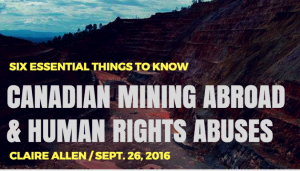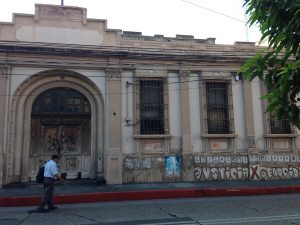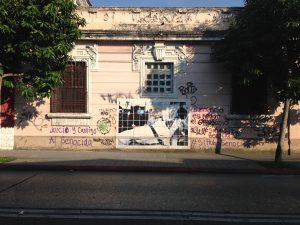
1. The good news about the Canadian mining sector.
For proponents, the mining sector in Canada is a major economic powerhouse. 75% of the world’s mining companies are headquartered in Canada.[1] Around 1,500 mining corporations based in Canada operate approximately 8,000 sites in over 100 countries. The Government of Canada lauds the mining industry as a “major contribution to Canadian prosperity, and… making substantial contributions to economic development in other countries in which they operate.”[2]
With 1994’s North American Free Trade Agreement, the mining industry in Canada expanded with opportunities to make agreements with foreign nations for the purpose of mineral extraction. Despite reports of violence, environmental grievances, and corruption associated with mining sites operated by Canadian companies abroad, operations have increased, primarily operating in parts of Eastern Europe and Central Asia, Asia, Africa, and Latin America. In 2013, mining accounted for $54 billion of the $1.87 trillion Canadian gross domestic product (GDP).[3]
- Why is Canada a haven for mining headquarters?
Canada has a long history with natural resource extraction, from early gold rushes and coal mining to now, with oil and gas industries and domestic and international mineral exploration. Over time, Canada has developed a competitive advantage in extractive sector finance and legal expertise. Furthermore, the corporate framework in Canada is lenient: mining corporations enjoy tax credits, one does not need to be run by a Canadian citizen or have Canadian shareholders to have headquarters in Canada and the requirements to list on the Toronto Stock Exchange are fairly casual, as are corporate disclosure conditions.[4]
- The bad news about the Canadian mining sector.
Despite claiming corporate social responsibility and “establishing and maintaining good relationships and strong partnerships with communities,”[5] Canadian mining corporations and the work of their foreign subsidiaries have been fraught with reports of environmental degradation, lack of consent from local communities, increased violence, and human rights violations including kidnapping, extortion, extrajudicial killings, forced displacement, rape, intimidation, and land seizes.[6] Activists who speak out in their countries against mining can face perilous circumstances. In Honduras, where 90% of mining is by Canadian corporations, 101 environmental activists were killed between 2010-2014, with scant prosecutory success.[7]
- Global calls for changes to the status quo.
From publications by groups like the Canadian Network on Corporate Accountability (CNCA) and Mining Watch, to protests in Vancouver,Toronto, Colombia, Nicaragua, Mauritania, Ghana, and Greece, public outcry has been occurring.[8] Despite the protests and pushes to obtain prior and informed consent from locals before beginning mining operations, Canadian owned mining sites are still proceeding with development, even in areas like rural Guatemala where in July 2016 it was reported that 98.6% of local residents voted against a subsidiary of Vancouver-based Tahoe Resources’ El Escorpion mine.[9]
- The Canadian legal system and the dark side of overseas mining.
The Canadian legal system has historically protected Canadian parent corporations from the actions of their subsidiaries abroad. Traditionally, courts in Canada have not heard cases of human rights violations based on the doctrine of non conveniens, which defers the case to the state that the incident occurred in.[10]
A 2005 report from the Standing Committee on Foreign Affairs and International Trade, or SCFAIT, outlined the key issue with poor behaviour at Canadian mining sites abroad as the undeclared impunity in operating in foreign zones with weak legal systems. The report concluded a need to “establish clear legal norms in Canada to ensure that Canadian companies and residents are held accountable.”[11]
The 2005 SCFAIT report led to legal reform conversations and subsequent adoption of a Corporate Social Responsibility (CSR) model in 2009 to promote “Canadian values and operate abroad with the highest ethical standards.”[12] A landmark 2013 case in the Ontario Superior Court of Justice (Choc v Hudbay Minerals) alluded to an unprecedented move by a Canadian court to regulate and rectify human rights abuses abroad by Canadian companies[13]. While the Choc v Hudbay and the move towards CSR are promising, bills to increase accountability such as 2010’s Bill C-300 flopped in Parliament. Activists remain skeptical of the tangible impact for those negatively impacted abroad, while United Nations panels have battle with Ottawa over treaties involving allegations with Canadian mines.
- Speculation on Canada’s mining future and human rights abuses.
Canada’s current Prime minister, Justin Trudeau, has not directly addressed the violations associated with Canadian mining abroad, though he did back Bill C-300 and the Liberals wanted an impartial ombudsman office to monitor Canadian corporate conduct overseas. While Trudeau won with promises to increase consultation with Canadian indigenous groups, activists abroad are calling for this to be extended to affected indigenous and marginalized peoples where Canadian foreign mining occurs. Time will tell if the Trudeau maintains his promises, and similarly remains to be seen whether deleterious mining practices will be allowed to continue, or whether they will be remedied through the Liberal campaign platform that supported “innovation and the use of clean technologies” in mining, and usher in a “new era in Canadian international engagement.”[14]
[1] Andrew Lodge, “Dark side of Canadian mining activities overseas brought to light,” Vancouver Observer, November 12, 2014.
[2] “Canada’s Enhanced Corporate Social Responsibility Strategy to Strengthen Canada’s Extractive Sector Abroad,” Global Affairs Canada, last modified Sept. 09, 2016, http://www.international.gc.ca/trade-agreements-accords-commerciaux/topics-domaines/other-autre/csr-strat-rse.aspx?lang=eng.
[3] Michelle Mark, “Canadian Mining Human Rights Abuses: What Justin Trudeau’s Liberal Party Win Could Mean For Latin America,” International Business Times, October 21, 2015.
[4] Dave Dean, “75% of the World’s Mining Companies are Based in Canada,” Vice News, July 09, 2013.
[5] “Delivering Sustainable Value to Our Communities,” GoldCorp, Blog Posts, July 11, 2016. http://www.goldcorp.com/English/blog/Blog-Details/2016/Delivering-Sustainable-Value-to-Our-Communities/default.aspx
[6] Rob Wipond, “Canadian mining races to the bottom,” FOCUS online, February 2013. http://focusonline.ca/node/503
[7] Marina Jimenez, “Honduran activist wants Trudeau to pressure Canadian mining companies on human rights abuses,” August 16, 2016. https://www.thestar.com/news/world/2016/08/16/honduran-activist-wants-trudeau-to-pressure-canadian-mining-companies-on-human-rights-abuses.html
[8] Santiago Ortega Arango, “Canadian mining companies subject of worldwide protests,” CBC, Apr 03, 2013. http://www.cbc.ca/news/world/canadian-mining-companies-subject-of-worldwide-protests-1.1368155
[9] “Guatemalans Demand Answers from Distastefully-Named Gunpoint Exploration,” Mining Watch, July 16, 2016. http://miningwatch.ca/news/2016/7/6/guatemalans-demand-answers-distastefully-named-gunpoint-exploration
[10] Susana C. Mijares Peña, “Human Rights Violations by Canadian Companies Abroad: Choc v Hudbay Minerals Inc”, UWO Journal of Legal Studies, 2014: http://ir.lib.uwo.ca/uwojls/vol5/iss1/3.
[11] House of Commons, “Fourteenth Report”, Standing Committee on Foreign Affairs and International Trade, 38th Parliament, 1st Session, 2005. http://publish.uwo.ca/~cyano/UWOTrick/Past_Handouts_files/SCFAIT%20Report.pdf
[12] “Canada’s Enhanced Corporate Social Responsibility Strategy to Strengthen Canada’s Extractive Sector Abroad,” Global Affairs Canada, last modified Sept. 09, 2016, http://www.international.gc.ca/trade-agreements-accords-commerciaux/topics-domaines/other-autre/csr-strat-rse.aspx?lang=eng.
[13]“Choc v. Hudbay Minerals, Inc. 2013 ONSC 1414,” Ontario Superior Court of Justice, July 22, 2013. http://www.chocversushudbay.com/wp-content/uploads/2010/10/Judgment-July-22-2013-Hudbays-motion-to-strike.pdf
[14] David Hill, “Can Canada’s new PM stop mining abuses in Latin America?” December 14, 2015. https://www.theguardian.com/environment/andes-to-the-amazon/2015/dec/14/canada-justin-trudeau-mining-abuses-latin-america



